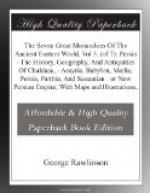Excellent stone for building purposes was obtainable in most parts of the Empire. Egypt furnished an inexhaustible supply of the best possible granite; marbles of various kinds, compact sandstone, limestone, and other useful sorts were widely diffused; and basalt was procurable from some of the outlying ranges of Taurus. In the neighborhood of Nineveh, and in much of the Mesopotamian region, there was abundance of grey alabaster, and a better kind was quarried near Damascus. A gritty silicious rock on the banks of the Euphrates, a little above Hit, was suitable for mill-stones.
The gems furnished by the various provinces of the Empire are too numerous for mention. They included, it must be remembered, all the kinds which have already been enumerated among the mineral products of the earlier Monarchies. Among them, a principal place must, one would think, have been occupied by the turquoise—the gem, par excellence, of modern Persia—although, strange to say, there is no certain mention of it among the literary remains of antiquity. This lovely stone is produced largely by the mines at Nishapur in the Elburz, and is furnished also in less abundance and less beauty by a mine in Kerman, and another near Khojend. It is noticed by an Arabian author as early as the twelfth century of our era. A modern writer on gems supposes that it is mentioned, though not named, by Theophrastus; but this view scarcely seems to be tenable.
Among the gems of most value which the Empire certainly produced were the emerald, the green ruby, the red ruby, the opal, the sapphire, the amethyst, the carbuncle, the jasper, the lapis lazuli, the sard, the agate, and the topaz. Emeralds were found in Egypt, Media, and Cyprus; green rubies in Bactria; common or red rubies in Caria; opals in Egypt, Cyprus, and Asia Minor; sapphires in Cyprus; amethysts also in Cyprus, and moreover in Egypt, Galatia, and Armenia; carbuncles in Caria; jaspers in Cyprus, Asia Minor, and Persia Proper; the lapis lazuli in Cyprus, Egypt, and Media; the sard in Babylonia; the agate in Carmania, Susiana, and Armenia; and the topaz or chrysoprase in Upper Egypt.
The tales which are told of enormous emeralds are undoubtedly fictions, the material which passed for that precious substance being really in these cases either green jasper or (more probably) glass. But lapis lazuli and agate seem to have existed within the Empire in huge masses. Whole cliffs of the former overhang the river Kashkar in Kaferistan; and the myrrhine vases of antiquity which were (it is probable) of agate, and came mainly from Carmania, seem to have been of a great size.
We may conclude this review by noticing, among stones of less consequence produced within the Empire, jet, which was so called from being found at the mouth of the river Gagis in Lycia, garnets, which are common in Armenia, and beryl, which is a product of the same country.




